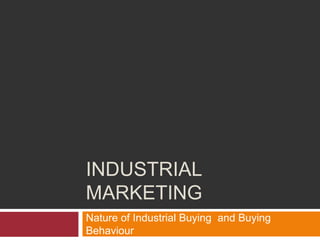
INDUSTRIAL MKTG 2
- 1. INDUSTRIAL MARKETING Nature of Industrial Buying and Buying Behaviour
- 2. Buying Objectives / Motives Organizational purchase objective is defined as buying the right items, in the right quantity, at the right price, for delivery at the right time and place. The management defines what is “right” for each dimension. Two major categories of organizational buying objectives are: (a) Economic or Task Objectives; (b) Non-economic / Non-task Objectives
- 3. Economic Buying Objectives Delivery / Availability Product Quality Price Reliability of Supply Service Reciprocity
- 4. Non-economic Objectives Prestige Career Security Personal Relationships Political Factors Social Factors Vested Interests
- 5. Types of Business Markets Commercial Enterprises Industrial Distributors / dealers (middlemen, resellers) Original equipment manufacturers (OEM’s) (Exide for Maruti Suzuki) Users / Industrial customers (TVS, Tata Motors) Government Customers PSU (BHEL, ONGC) Govt. Undertakings (Indian Railways, Electricity Boards, Defence units) Organizational / Institutional Customers Public Institutions (Govt. hospitals, prisons) Private Institutions (Pvt. Hospitals, schools, colleges) Not-for-profit (charitable) organizations (Temple trusts, orphanage) Cooperative Societies Manufacturing units (State Sugar Coop Society, AMUL, PARAG) Non-manufacturing units (Cooperative banks, housing societies)
- 6. Factors in Business Buying Webster & Wind Model summarizes the factors influencing business buying decisions: Environmental Factors Organizational Factors Buying Centre Factors Individual Factors Physical Goals & Tasks Roles Status Economic Technology Resources Politics Technological Actors Ethics Legal & Political Structure Cultural
- 7. Buying Centre Roles Initiator Influencers Users Deciders Buyers Gatekeepers
- 8. Organizational Buying Process / Stages 1. Recognition of problem or need. 2. Determination of the characteristics of the item and quantity needed. 3. Specifying the requirements. 4. Search for potential suppliers. 5. Acquisition & analysis of supplier proposals. 6. Evaluating & selecting suppliers. 7. Selecting of an order routine. 8. Performance feedback & evaluation.
- 9. The BUYGRID Model Robinson et al have identified 8 buy phases (stages), and 3 buy classes (situations). The THREE major Buy Classes (Situations) are: New Purchase (or New Task) Repeat Purchase (or Straight Re-buy) Change in supplier (Modified Re-buy)
- 10. Analytical Framework of BUYGRID Model Buy Situations Buy Classes New Task Modified Re- buy Straight Re- buy Problem Recognition Yes May be No Determine characteristics & quantity Yes May be No Description of requirements Yes Yes Yes Search for potential suppliers Yes Yes No Acquisition & analysis of proposals Yes Yes No Evaluation & selection of supplier Yes Yes No Selection of order routine Yes Yes No Performance feedback & evaluation Yes Yes Yes
- 11. Industrial Purchase System Purchasing practice in Commercial Organizations (large & medium size) is quite complex and involves several departments like production, stores, materials, quality, finance, accounts, engineering, etc. The purchase practices change on the basis of nature of business, size of operations, volume, variety, and technical complexity of the products to be purchased.
- 12. Major Purchase Steps User Dept. initiates process by issue of PR (purchase requisition) or indent to purchase / material dept. Material dept. checks availability of stock. If not in stock then identify suppliers, get quotations, negotiate, select supplier and issue PO (Purchase Order). Receipt of material, check challan against PO, issue MRR material receipt report). Quality control dept. inspects material and issues IR (Inspection Report). Purchase dept. sends supplier invoice along with MRR & IR to accounts for release of payment to supplier. Materials dept. dispatches the required material to user dept.
- 13. Purchasing in Government Units 1. DGS&D finalizes running contracts for standard products for Central Govt. Units. 2. In other State Govt. Units the products and company first gets registered as approved supplier. 3. For standard products tender notices are advertised in newspapers. Tenders are procured by suppliers, filled & submitted in sealed covers specifying all technical and commercial details of supply.
- 14. Purchasing in Government Units 4. Competitive bids are used in purchase of both standard and special items. 5. In case of Closed and Limited Tenders the bids and not opened or announced in open; which is done in case of Open Tenders on the tender opening date. 6. L1, is the lowest bidder calculated in terms of landed price. L2, L3, etc are called for negotiation if they agree to offer the similar landed price, PO is released in their favour.
- 15. Purchasing in Government Units 7. On receipt of supply in stores, inspection is carried out and report submitted to concerned dept. and also to accounts. 8. Follow-up is done in a case the supplier fails to supply the entire lot in time. Or material receipt is not in accordance with the supply specifications or does not match the PO. 9. If receipts match the PO and stands approved by all concerned departments the relevant documents are sent to Accounts for release of payment as per agreed terms and the existent Rules and Policy of the Govt. Unit. 10. Auction and Reverse Auctioning.
